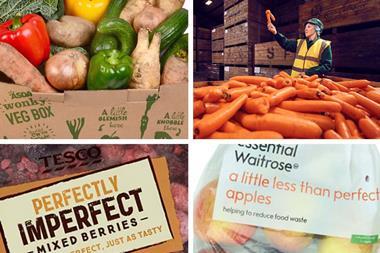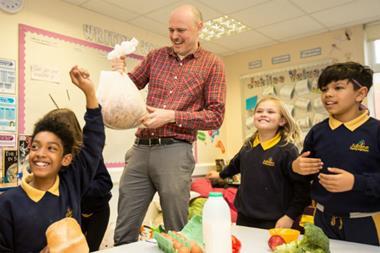Robots don’t waste food. People do. At least that’s the premise behind a new industrial R&D project that plans to bring state-of-the-art robotics to the factory floor in a bid to slash waste.
Seven per cent of global greenhouse gas emissions are due to food waste, according to Wrap, which also estimates 1.7 million tonnes of food and drink is wasted along the supply chain in the UK per year. That’s 89% of all food wasted by the industry, long before products reach supermarket shelves. Crucially, 51% of this waste is avoidable, equal to 1.5% of output across the £110bn manufacturing sector, says the charity.
But by bringing together expert roboticists, engineers, computer scientists and food specialists, a venture that kicked off in March plans to address this waste and the inefficiencies that lie behind it.
How else are robots helping to cut waste?
The robotic chef: In 2016 OA unveiled ‘April’, a robotic production system that emulates the work of a chef and helps to “improve taste, consistency, quality and value” while reducing wasted ingredients in ready meals and other chilled foods.
The mini fieldworker: Academics at a number of UK universities are researching ways in which robots could be used in crops to identify produce too small to be harvested, leaving it more time to grow and removing the likelihood of it falling foul of high retailer specification.
The robotic recycler: The result of a collaboration between two US companies, ‘Clarke’ can sort through 60 cartons per minute with near-perfect accuracy, say its creators.
Led by Olympus Automation (OA) in collaboration with the University of Lincoln’s National Centre for Food Manufacturing and supplier English Provender, the initiative has received £900,000 in funding from Innovate UK.
The target of the two-year project will lie in removing human error from the crucial early stages of handling, preparing and weighing raw ingredients, says Jake Norman, innovation and marketing manager at OA.
“Even when you go round the really large manufacturers, you’ve still got a person weighing out ingredients with a scoop, which is baffling because it’s a task that’s critical to making the product right,” he says. “If you put in the wrong amount of flour at the start, or more critical ingredients like starches, the product could be rejected down the line.”
These mistakes can also be hugely costly, adds Norman, with up to 5% of turnover associated with the handling and preparing of these ingredients.
Now a “perfect storm of that labour supply becoming more of a challenge, the cost of labour going up and also more pressure on industry to work more efficiently” means businesses are looking to modernise, says Mark Swainson, deputy head of the National Centre for Food Manufacturing at the University of Lincoln.
Coupled with that are the rapid advancements and declining costs of robotics technology. The project plans to capitalise on those factors by designing, building and bringing to market a robot capable of weighing and measuring ingredients, “effectively automating all the material handling elements of a business,” explains Norman.
State-of-the-art robotic arms can already weigh out powdered ingredients “on demand to the accuracy of one gram” but experts will spend the next 24 months tweaking the tech to be able to handle lumpy foodstuffs like frozen onions, or sticky ones, like treacle or honey.
On top of that will be the need to ‘teach’ robots to judge apples from oranges, explains Swainson, using vision systems “to look for the material, to be able to pick it up, orient it, place it in the right place and at the right time”.
“The challenge is making sure the system is well designed, accurate and repeatable,” he adds. “It’s about fine-tuning for individual applications and understanding different ingredients for the mix of different businesses and making sure it can handle those ingredients on the accuracy and output rate that businesses require.” A reasonable payback period is also a “key factor” if businesses are to engage.
It could take considerable time and investment, but it’s a change businesses are hungry for, Swainson insists. “There’s a lot of interest and awareness growing in the manufacturing sector about food waste but the sector also needs help and support on that journey. It’s such a busy sector that if you don’t make it easier it’ll continue to do things the way it always has. It needs real-world practical solutions to the challenge.” Or a helping (robotic) hand.



















No comments yet